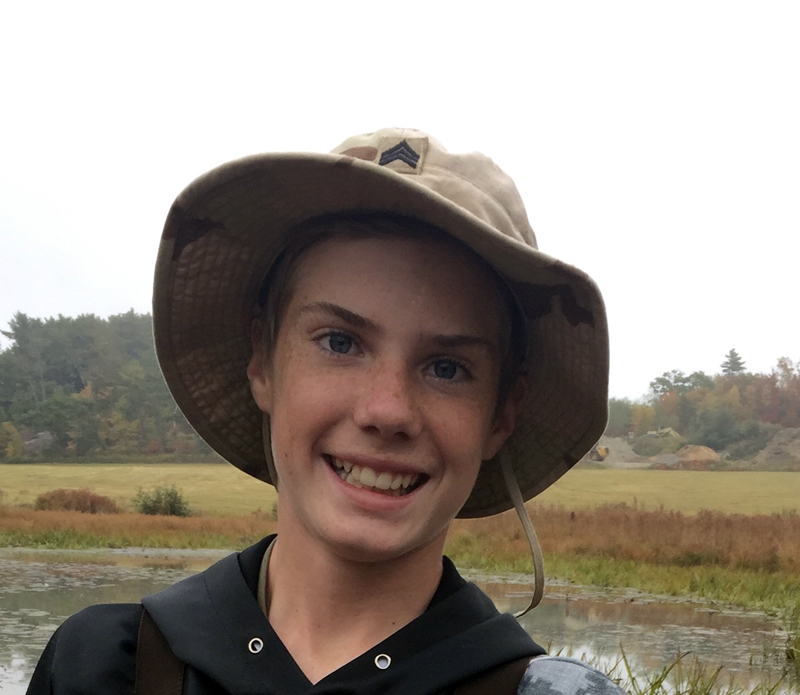
Although adjustments needed to be made due to the COVID-19 pandemic, we are thrilled that the GSB Students Investigate program continued for its fourth year.
Since 2017, The Lincoln County News has collaborated with Kelly Girard and her eighth-grade language arts classes at Great Salt Bay Community School in Damariscotta. Similar to years past, the students kicked off their investigative journalism unit by learning about community journalism. The major difference this year was that the visit took place over Zoom, rather than in person.
The students then wrote their own investigative articles, a collection of which are published below for the enjoyment of LCN readers. Beyond some small edits to bring the articles into Associated Press style, the articles are largely untouched to preserve the voice of the young journalists. Unsurprisingly, the articles are wonderful, and cover a wide range of topics both in our community and beyond.
As always, I want to thank Girard for continuing this project and her students for their hard work!
Engaging our next generation of readers is a major focus of The Lincoln County News. If there are any teachers out there who would like to have someone from the LCN come speak to your class, give us a call at 563-3171 or email mzewert@lcnme.com and we’ll do our best to accommodate the request.
CMP corridor: good or bad?

By Eli Melanson
A much disputed issue, the Central Maine Power corridor, has caused lots of protest from the residents of Maine.
In 2016, Massachusetts passed a law that stated the state must have a certain percentage of renewable energy, which they decided to purchase from Hydro-Quebec. The corridor, which stretches from Beattie Township to Pownal, is 145 miles long, 92 of which are already built. It is a transmission line, which carries very large amounts of power that are then distributed out to residents through regular power lines.
Originally, all of the energy was going to go to Massachusetts, but due to public upset, 950 megawatts will go to Massachusetts, and over 350 megawatts will be delivered to Maine at a discounted rate. The New England Clean Energy Connect, a new company that will own the corridor, says that the project will lower $14 million to $44 million per year in electricity costs. The New England Clean Energy Connect also says that 3-3.6 million metric tons of regional CO2 emissions will be reduced, which is the equivalent of taking 700,000 cars off of the road each year.
CMP’s research shows that the companies paying for the commercials that oppose the corridor are fossil fuel companies, such as NEXTERA, a large gas company has several plants in Maine, and will lose business if the project proceeds. The New England Clean Energy Connect says that the project will generate 1,600 new jobs each year for five years in western and southwestern Maine, and that they will be looking to hire as many Mainers as possible.
The corridor has several well-known environmentalists supporting the project, such as two former directors of the Natural Resources Council of Maine and the former president of the Maine Audubon Society. CMP Manager of Corporate Communications Catharine Hartnett said that some studies show that Maine could have all of the solar and wind energy available to us, but it still wouldn’t be enough.
“Hydro works when the sun isn’t shining and the wind isn’t blowing,” she said. “We need to think bigger.”
However, lots of Mainers still oppose the corridor. The Natural Resource Council of Maine, said that the project will “generate billions of dollars of profit for CMP and Hydro-Quebec while offering very little to people and businesses.” They are also collecting signatures for a petition to stop the project. The Natural Resource Council of Maine also said that the corridor will harm lots of wildlife in northern Maine, such as brook trout and deer.
Great Salt Bay staff members also express their concern for wildlife.
“The corridor will impact an area that I have had ties to since I was a kid. I am a whitewater rafting guide in The Forks each summer now as an adult. To see how the landscape and scenery had been tarnished with the Bigelow range wind turbine project. I would hate to see the pristine woods torn up by a huge power line,” Mr. Adickes, a GSB PE teacher, said.
Another staff member said “I enjoy walking through the Maine woods and watching wildlife in its natural habitat. Enjoy seeing and smelling the fragrance of the fresh earth and trees. So, part of nature would be destroyed.”
Lots of people support it, though. One GSB staff member made an interesting point. “The ecological footprint of the power corridor is much smaller than that created by coal burning plants. By accessing hydropower from an established reservoir the need for new, or existing outdated coal burning plants will be negated. The narrow path through northern Maine will not destroy or disturb the integrity of the habitat. It may actually increase wildlife habitat by breaking up some of the mono culture of the industrial forest of the area.”
Another said that the project will bring money to Maine, increase renewable energy available to Maine, and be supplied by a preexisting dam.
Other staff members express their anger at having someone else benefit from a power line that runs through Maine land. However, Hartnett said that the corridor will run through privately-owned land, most of it belonging to Central Maine Power.
“The National Resource Council of Maine is the project’s biggest challenger,” says Hartnett.
Both the Natural Resource Council of Maine and New England Clean Energy Connect are trying to get community support. Hartnett says that the project will begin construction in early 2021.
If you’d like to show your support, both organizations are looking for it!
Oysterhead Pizza Co.: taking their next steps into the future

By Tessa McNamara
In downtown Damariscotta, the pizza place that opened in 2019, Oysterhead Pizza Co., is taking steps into the future.
“Oysterhead Pizza Co. is a very unique restaurant…We are always working really hard to get better and better,” said Nick Krunkkala, who is the head chef at Oysterhead.
During these hard times in COVID-19, many small businesses have closed. Business owners are always thinking of ways to improve their business. Due to COVID-19, business owners are trying to get better and better to attract more business and customers.
Caroline Zeller, who works at Oysterhead creating bagels, cakes, pies, bread, and more, said “We were so lucky to be providing food before COVID because it was already desired food.”
Oysterhead Pizza Co. started making unique food before the pandemic hit. Because of their popular food, customers already wanted their new items that were provided at the restaurant.
At Oysterhead Pizza Co., the changes to make the restaurant more COVID-safe were put into action quickly.
“We made masks required at all times even when it was not required by law,” said Zeller.
Krunkkala said that indoor seating was stopped and tables that were spread out were put on the deck. Take out and curbside pickup also started.
Alex Nevens who owns Oysterhead Pizza with his wife Rachel Nevens, said, “We began to follow state and federal regulations along with the CDC guidelines… soon, we allowed outdoor seating.”
As winter approaches, and outdoor seating is not an ideal option, Oysterhead Pizza is looking to have different types of meals.
“More of a one stop and shop,” said Zeller. According to Krunkkala, curbside pickup and contact listing will be the main ways to get food to customers. Nevens said that the company will be concentrating on takeout and their future delivery options. In an article written about Oysterhead Pizza by Maia Zewert, who works at The Lincoln County News, a delivery option was mentioned. But the delivery option has been taken into more consideration and thought. As said above, it will most likely be put in action this winter.
Some people wonder what is next for Oysterhead Pizza. Nevens said that the company will be keeping all of their barriers and COVID supplies.
“We are going to be very prepared if this ever happens again,” Nevens added. Soon, Oysterhead Pizza Co. plans to expand their seating options. They are thinking about putting back bar stools when it is safe for people to gather.
“We plan to make it really fun for next summer,” said Nevens.
In the future, plans to improve the business have been on the employee’s minds. Krunkkala said that a delivery system might begin, especially in the winter time. For this to happen, the employee or employees delivering the food would have to have insurance for the business and get a license to be able to deliver. Also, Zeller said, “We have plans to expand our meal options as far as getting food that is hot and ready to go and food that you can take home and heat up.”
As far as expansion, Oysterhead Pizza employees have been thinking about opening a second Oysterhead Pizza.
“It’s something we are thinking about…but not rushing it,” said Nevens. He also added that when opening a second business you need to be careful.
Most recently, Oysterhead has launched some merchandise. Nevens said that he likes their employees to wear their merchandise. They now sell hats, sweatshirts, and long sleeve T-shirts. “We believe that we have a pretty cool logo and a pretty cool brand so we decided to make some hats, shirts, and sweatshirts,” said Nevens.
Oysterhead Pizza Co. is taking their next steps into the future. The employees are always thinking of new ways to improve. They are currently working out a delivery option while they have merchandise selling. During COVID-19, Oysterhead Pizza Co. stopped indoor seating. Tables were put outside and masks became required at all times.
“We are taking it day by day…Always trying to improve the quality of our food,” said Krunkkala.
Next time you are driving by, maybe try it out. Not only has this restaurant made improvements, but it is a unique dining experience.
Universal mandates and the effects on the community

By Kellen Adickes
What does normal society look like? It looks like people getting together, having a good time, helping support one another. As of March, our state has seen the effects of a global pandemic. However, there are certain decisions that the people in charge have made that have put the society we know in jeopardy. Certain mandates just don’t make sense to the minds of many members of the community.
The first example has been the impact on the small business community. According to maine.gov, as of Nov. 20, Gov. Janet Mills announced, that to slow the spread of COVID-19, all outdoor and indoor amusement venues, movie theaters, performing art venues, casinos, and businesses that provide seated food and drink service, including social clubs, restaurants, and bars and tasting rooms currently open for outdoor service, will close for the night by 9 p.m. This executive order has been extended to Jan. 3, 2021. Many people know our community is based on small businesses such as the ones listed above. Many small businesses will experience rough times financially from these orders, if not already.
From mainesmallbusiness.org, “the COVID-19 crisis poses an unprecedented threat to our small businesses. Many of us have had to lay off employees who have been with us for years, are struggling to pay rent, and will likely lose our livelihoods unless our government acts swiftly.”
One small business owner in Newcastle has felt the effects of universal mandates. Brie McCarthy, owner of Lavish, said that she has lost “20-25%” of her income since she re-opened in the spring due to a shut down.
“The 6-foot rule has hurt me the most,” said McCarthy. She was required to take out one of her three hair-cutting stations to comply with the 6-foot social distancing rule.
The effects on small businesses have been rough. They have posed some questions, such as if it is possible for some of these mandates to be eased to help the population of small business owners. Some of the restrictions are more painful to certain businesses than others. The most practiced mandate is the mask mandate. Do the masks actually work? The masks are to keep potential viruses such as COVID from spreading to other people. However, according to cdc.gov, “A cloth mask does not provide an airtight fit across the face.” Does this mean that some water molecules carrying the virus could escape? Wearing a mask might not appeal to some people’s liking, according to input from close friends in the past, so this could deter them from visiting a small business.
Effects such as this may not be good for the economy, but is it necessary? Some statistics suggest that universal mandates may not be necessary. As of Dec. 7, Lincoln County’s total COVID-19 case count, according to the Maine Center for Disease Control and Prevention, was 168 positive cases since March. As of 2018, according to the U.S. Census Bureau, the population of Lincoln County was about 34,000 people. The rate of confirmed cases to the population is just under .5%. Only two people have been recorded passing away with the virus.
Now let’s compare that to Cumberland County. Cumberland’s population, according to the U.S. Census Bureau, was about 295,000 people as of 2018. Their rate of confirmed positive cases to the population as of Dec. 7 was about 1.25% (3688 confirmed cases as of March). That’s still not as bad as some of the hot spots in the country, but it is over twice the rate of cases to the population than in Lincoln County. That is why universal mandates don’t make sense in this situation.
The next time a leader makes a decision putting our culture at risk, ask yourself this question; Is it really necessary? This isn’t to persuade anyone to think a certain way, this is to make you aware of some questionable decisions that might hurt other people, or maybe even you, without realizing it.
The history behind the Jake Day dioramas

By Zofie Day
The Jake Day dioramas, which are boxes with amazing Christmas scenes painted in them, are located in Newcastle at Milling Around. Visitors can see them lit up from sunset till 9 p.m. during the winter holidays, from late November to late December.
Jake Day, who is the creator of the Christmas dioramas, died at 90 years old in 1983. The dioramas are still kept on display by the Roberts and Day families, who have kept them going for many years. Jake was born and raised in Maine, which might be the reason for why he loved the wilderness and nature so much. He had a camp up in T6-R8, which most people call Matagamon, that his family still owns. Back then, the camp was only for Jake’s Rangers, who he was a part of. Jake’s Rangers were a group of friends that shared a love for the outdoors, which led them to go on lots of adventures together.
Jake’s inspiration for making the Christmas dioramas was to bring joy to the community during Christmas time. He had a very imaginative mind, which led to him working with Walt Disney Productions in Hollywood, to help make the character Bambi according to Daniel Day, his grandson, who is now 74 years old. Daniel said that Jake just had the liking of making people happy during the holidays and sharing his creative ideas with the public.
Jake first started making the dioramas in the early 50s in a woodshed on the Bristol Road in Damariscotta, where the Mid Coast Addiction Resource Center is now. Daniel said that when he was a kid, he would visit Jake and there would always be sawdust on the floor from the carvings he would be making for the dioramas and other pieces of his artwork. Jake would later go on to sell some of his carvings in a log cabin, which he fondly called “The Whittle Shop,” during the summertime, where the Day Nash Insurance building on Route 1 is now.
According to Daniel, when he would tag along with Jake and some of his friends, Jake would always have a camera around his neck, and was always taking photos of wildlife up north, which might have had something to do with his inspiration for some of the dioramas. That was all Daniel said about Jake’s inspiration for the dioramas because what happens up north, stays up north! That is a motto the Days live by. Jake also took photos of nature and wildlife in southern parts of Maine, which he would use for some of his dioramas and paintings for inspiration.
When the dioramas were still on display on the Bristol Road in Damariscotta, there was a book that people would sign if they were there visiting the beautiful carved dioramas. There were pages and pages of names and addresses in all sorts of different colors, in the small brown book labeled “Guest Book.” The dioramas were all around the building in almost all of the windows, lighting up the whole house in all kinds of vibrant colors. Almost every year, all of Jake’s grandchildren and great grandchildren sign the book in honor of him, and all of the accomplishments he had made in his lifetime.
When the dioramas were on display at the Farnsworth Museum in Rockland, they faded out from being left out in the hot sun for many years. Once people realized what had happened to them, a woman that was working at the museum took the time to help repaint all of the dioramas and restore the boxes they were held in. She dedicated many hours of her days to help restore them back to their original beauty and perfection.
In keeping with the Christmas spirit, you should go visit the dioramas at Milling Around in Newcastle from sunset till 9 p.m. during the months of November and December. They will be waiting for you with their vibrant lights in the windows, but sadly you cannot sign the guest book due to COVID-19 restrictions.
Gardens Aglow

By Lucy Fowler
Winter on the coast is cold, and with COVID-19 there isn’t much to do. Your toes get numb and sometimes it’s too cold for people to enjoy the lights and the fun of walking around. This winter season, even with COVID, Coastal Maine Botanical Gardens is hosting Gardens Aglow for the sixth year in a row.
Usually, Gardens Aglow is a walkthrough festival of lights, but this year, Gardens Aglow is a drive-thru light festival due to COVID. In your car, you can enjoy the lights, listen to music if you want, and stay warm this winter season.
Kris Folsom, marketing director of Coastal Maine Botanical Gardens said, “We had to decide if we did anything at all, if we wanted less visitors, or should we make it totally different. We decided to do something completely different. This kept people employed, helps people have something fun to do, and supports the staff and community.”
The Coastal Maine Botanical Gardens has the event Gardens Aglow to bring people joy and to have this activity during the holidays. People from all around Maine and other states come to Gardens Aglow to enjoy the lights and this year, the people from Coastal Maine Botanical Gardens have made it accessible for people in their cars to come see the festival of lights.
When people come to the Gardens Aglow with their family and friends, it brings them joy and happy spirits.
“My favorite part is the stories people tell and getting to hear people getting excited to come here and people singing and laughing,” Folsom says.
Because of COVID-19, Gardens Aglow has had to change it up.
“We really thought doing the walk through, there was no way to social distance everyone safely.” Folsom said when asked about what made you change the regular walking festival.
The Bangor Daily News interviewed Coastal Maine Botanical Gardens CEO and President Gretchen Ostherr, who said, “We wanted to find a safe way of continuing and honoring what’s become an annual tradition for so many families, our committee has worked hard to map out the safest, most accessible route, taking traffic and congestion very much into consideration.”
The Coastal Maine Botanical Gardens has taken everything into consideration and has a very COVID-safe campus. Although no one predicted COVID-19 would happen and shut down so many things the staff and executives at Coastal Maine Botanical Gardens have made a COVID-safe campus for everyone to enjoy.
“COVID has affected Gardens Aglow because it had to be made as a no touch area including tickets, restrooms and restaurants,” Folsom said about COVID precautions and effects.
Although you can’t go shopping at the Botanical Gardens you can visit their online shop at, shop.mainegardens.org. Because it’s a no-touch zone, tickets for Gardens Aglow have to be bought before and are recommended that you print them out yourself to limit touch at the gardens.
All of the regular staff helps set up for the light festival and no extra help is hired. This helps extend seasonal employees to help prepare flower beds and help string lights. Gardens Aglow helps bring families together and gives the community something fun to do during the holiday season.
How has regional theatre been faring during the pandemic?

By Joseph Levesque
The world has been upended by the COVID-19 pandemic, but how has regional theatre throughout the state weathered the storm?
Theatre and the arts contribute to a $150.5 million industry in the state of Maine, and, unfortunately, it has not done all too well since the beginning of the pandemic. It is estimated that theaters around the state have lost more than ten million dollars in revenue from ticket sales alone. This loss may cause many theater companies to close, in a survey done in Ohio 76% of respondents said that, without additional support, they would be closed within 12 months. And this is likely true in Maine as well.
Theaters are also in one of the last stages of reopening, which will only cause more to close, already Smitty’s Cinema in Biddeford has permanently closed their doors because of the unprecedented damages of the pandemic and the financial troubles that go along with it, though Smitty’s has not died because of the pandemic because of the other chain locations. However, many more are expected to follow that same path and not ever be able to recover. The Lincoln Theater, in downtown Damariscotta, is lucky enough to have enough backup money to survive while still being closed because of its generous benefactors.
The theatre industry also supports more than 4,000 full-time equivalent jobs across the state, and the nature of acting jobs do not allow much extended financial security, so they might be forced to abandon acting altogether to stay afloat. The theatre industry also supports the local economy by bringing in more than $12 million in local and state tax revenue.
Many theatres are looking to alternative ways to give people shows. One such way is by streaming the shows online, or with a much smaller audience size, though the latter is less preferable because of strict rules and regulations about sanitizing, mask requirements, and staying socially distanced as much as is possible. Since many theater are enclosed, the people that they can fit are ever more severely limited, and that means that tickets will have higher prices, which may further discourage people from going to the theater, and the ticket prices may not go back down for a while, which may cause more people to stop their theater-going altogether, further hurting the industry in the future as well.
Other requirements that limit how theatres can operate include firing or furloughing staff members to comply with the state spacing rules and to keep enough money to continue operating. The state also requires that they be outfitted with sanitizing equipment and increased cleaning and disinfecting practices. Another practice that is potentially very costly is the installation and use of expensive ventilation equipment. With all of the other operating costs and wages that the theatre needs to pay, this just adds to the unfortunate likelihood that they will not be able to operate any longer.
The world of theater, much like everything else, has been hit hard by the pandemic, and the fate of many small regional theater are still undetermined, and many will likely be forced to close for good. However, as long as there are arts-loving viewers, theater will survive, and eventually, there will once more be a full and booming industry.
COVID-19’s effect on a local restaurant

By Jhordaynia Ebanks
COVID-19 has taken a toll on all of us, small businesses, families, the economy and places all around the world. Que Rico, a small restaurant located in Damariscotta at 115 Main St, is one of the many restaurants in town like King Eider’s Pub, Racha Noodle Bar, Best Thai, and a few more that have taken a hit due to this current pandemic.
Restaurants around the world have started to use different methods to share their food.
“As restaurants around the United States are closing in an effort to stop the spread of the coronavirus, they’re also trying to keep their businesses alive by focusing on different service models,” Sara DeRico said. “It’s a bummer not to be able to seat a full dining room, even though ours is small, or have people eat at the countertops, but luckily our food works really well to serve to-go, and we do a lot of that.” Sara, like many other restaurant owners, is working hard to earn money for her restaurant.
Que Rico, on Google Reviews has a solid 4.6-5 star rating, that rating standing strong throughout the pandemic from June 4, 2019 till now. Though business has been slow, the restaurant still opens, just in case there happens to be at least one busy day during the week. You might remember the food truck that Que Rico used to be, it was great for tourists and had a nice river view. The restaurant in town is located near the docks, so you could order some food and go sit at one of the many picnic tables located on the waterfront or walk along the docks for some fresh air while eating a burrito or taco.
Que Rico, the name being slang for “Delicious,” and the owners’ maiden name being a key part, DeRico.
“I feel extremely lucky that we are in a small space, and do not depend on a lot of employees, and our food works so well to-go. We have never been dependent on a large, full dining room, or large bar. But it will feel good when we can get back to offering normal dine-in options to people,” said Sara.
She is very optimistic even though business is slow, especially during this time of year. While not serving indoors, beverages are still an option, if you don’t want any food. As an example they have classic Coca-Cola, Sprite, and many other beverages in store.
While the pandemic is still current and thriving, we should all remember to support whoever and whatever we can, while still wearing a mask and other necessities when going out. Support the small businesses and restaurants that are in Lincoln County, you might not have lots of money but there are cheaper options on the menu, like the churros.
Que Rico, like many other restaurants in town, need support during this pandemic. Just stop by and grab a drink to-go or a churro and enjoy.
The decrease of the right whale population in Maine

By Tanner Peaslee
In 2020, the population of right whales has decreased. Because of this, Maine’s lobstermen must put three feet of purple rope on their buoys. Additionally they must put one-foot tracers every 100 feet. Tracers are a small string wrapped into the main rope. If a whale gets caught in a Maine lobstermen’s rope the rope can be identified by this purple rope.
Are whales getting caught in lobsterman’s rope? According to the National Oceanic and Atmospheric Administration, an online site that gives facts about the Maine waters, there have been no recorded right whale deaths due to rope, however, it is still possible a right whale can get tangled in rope and die. National Oceanic and Atmospheric Administration also said it is not likely for a whale to die from rope entanglement, however, whales can get injured and scared from the ropes. These scars and injuries can cause the whales to get hit by ships.
If the whales are not dying from rope entanglements, why should the lobstermen have to put purple rope into their main ropes? Purple rope costs more money because of the dye used in the rope. If this rope costs more is it affecting the lobstermen. According to Steve Peaslee, a local lobsterman, putting in purple ropes was more of a hassle than a cost of money.
Is the purple dye affecting the ocean? The dye in the rope is not toxic to the environment because the dye is made from sea snails. But is catching the snails for the dye harming the environment? According to theconservationcenter.com, about 12,000 snails are used to make 1.4 grams of purple dye. At 34 pounds for a coil of rope that’s a lot of snails. Sea snails are dropping in population because of the habitat being broken due to sea snail catches.
In addition to having to put purple rope into the main ropes, lobstermen must also be putting whale safe breakaways on their buoys. Whale safe breakaways are plastic ring swivels that have a 660-pound breaking point. This means if a whale swims into the rope it will break this piece of plastic and be free. Although this benefits the whales, it can also harm the whales and other sea life. About a million seabirds die every year because of harmful plastic in the ocean. As for the other marine mammals, about 100,000 of them die every year because of plastic. That’s a lot of animals.
Lobstermen must put three feet of purple rope on the buoy down. This is because of right whale entanglements in rope. Although there have been no reports of right whale dying due to rope, researchers have still found scars and wounds due to rope. These rope scars can affect right whales to then get hit by a boat or ship struck. Lobstermen must put 660-pound whale safes on the buoys but this could be harming the oceans by itself. Also because of the purple ropes the population of sea snails is dying because of their habitat being killed and destroyed.
STEMports augmented reality game coming to Damariscotta

By Calvin Percy
In late October of this year, several students from grades 7 and 8 at Great Salt Bay Community School in Damariscotta found an email in their inboxes inviting them to take part in the creation of an augmented reality game that focused on ecology. These students were a few of many students in schools across Maine that have been asked to take part in this exciting experience.
On Friday, Dec. 11, the author interviewed Scott Byrd of the Maine Math and Science Alliance.
“(The game) doesn’t have a title yet, but if you think of anything, let us know,” said Byrd.
Byrd has been working with students for the past three years, helping them playtest and author the game, which is a collaboration between Maine Math and Science Alliance and Field Day Labs, an organization from the University of Wisconsin in Madison. The project is funded by the National Science Foundation.
“(The National Science Foundation) is really into getting teens interested in science through quest based games,” said Byrd. Field Day Labs has also produced several other games, and is the leader in games that help kids, teens, and adults learn about science.
Byrd’s also been having workshops across the state, letting people know about ecology, as well as telling people about the STEMports project.
“We really want to get more people involved with the game…We think they’ll find it fun because they can help to actually make the game, as well as play it,” said Byrd.
Byrd has also been working with the other members of the STEMports team, who mostly work in cooperation with the Maine Organic Farmers and Gardeners Association, including Ruth Kermish-Allen, Sue Allen, Susannah Gordon-Messer, Brittney Nickerson, Kate Kastelein, Gary Lewis, and Sierra Toomey.
So, how exactly would a player go through this game, and where could they get it? It is currently unavailable to the general public.
“The game is currently only on TestFlight (the testing platform that allows the student playtesters to play the game), but once it’s out, it will be on the Apple app store,” said Byrd.
The game consists of tour stops and caches. The tour stops are represented on the map by signs, and the caches look like treasure chests. The tour stops have information written on them, which a player can read and use in observations. The caches contain field notes, which are then sorted at the end of the quest. The caches can also give a player puffin snacks, which as of yet have no function that furthers a player’s progress in the game, as all they are used for is to feed the puffin avatar that appears in the corner of your screen. The puffin, when fed, will glow and a speech bubble will appear saying something about how good the food was. The field notes contained in the caches are sorted into different categories which are determined by the quest.
After the field notes have been sorted, the player makes one or more observations, which can consist of a photograph, a short written answer, or answering a multiple choice question. These observations help players learn about the topic at hand. When the player has completed all of the required observations, the quest is over. Then, more quests can be downloaded.
New material is being added to the game by the GSB students, which will be located in Damariscotta. More material, focusing on local agriculture, is to come, according to Byrd.
“We’re developing a lot of quests about small scale agriculture in Lincoln County. It really lets people see the connection between farm and table,” he said.
Byrd finished by saying that he thought the game really helped kids and teens learn about their community. “They’re also learning about their community, because they’re doing hands-on research to get the content for the game.”
Byrd said the game will hopefully be out in the spring of 2021.
Fundraising for a skate park in Damariscotta

By Roan Donaghy
Fundraising requires a great deal of work and help from the community, as well as other individuals and organizations who raise money for nonprofit causes.
The Damariscotta Police Department has asked local Damariscotta businesses for potential land to donate for a skate park. The Damariscotta Skaters committee has worked hard to find skaters a place to have fun without getting in trouble.
“The key is to find and ask the right people who would help,” said Kristin Rivas, a local, experienced fundraiser.
What would skaters need to do to start a fundraiser?
“They would need to come up with a plan before they release it, a plan for location, how much money you will need, who would build it, maintain it, etc.,” said Amy Micklich, a staff member of Great Salt Bay Community School.
The Damariscotta Skaters Committee has created a group that is working on a plan to find resources and places so they can begin fundraising. The Damariscotta Skaters Committee is a group located on Facebook who are making an effort to find local skaters a safe place to skate. The Damariscotta Skaters Committee will need to talk to the skaters about their plan, so they can launch the fundraiser and begin fundraising as soon as possible.
“The best way to reach your goal is to stay smart, prepared, and organized,” says Rivas.
When will we reach our goal? People often give up because of loss of hope and interest. Fundraising is a very difficult task, because we have a small community and skating isn’t a priority to most residents, so fundraising will probably take even longer.
“Skaters could gain popularity by setting up stands and posters in front of local Damariscotta businesses,” said London Hunter, a local skater.
Where would our park be located in Damariscotta? The Damariscotta Police and the Damariscotta Skaters Committee have been trying to find skaters a place to skate and have fun for over four months now. It is a challenging process because there are so many rules that would apply, such as liability insurance, safety precautions, and possible lawsuits – or even the threat of being sued. Many local businesses would require you to sign a waiver, or would apply strict rules to the skate park. Since many of the local skaters attend GSB, they would prefer to have the skate park in a location near the school, so they could access it easily.
Damariscotta needs a skate park because of all the incidents skaters have had with pedestrians, police, and business owners, and for public safety reasons. Skateboards are loud and disruptive to the public. When people see a skateboarder flying around and being reckless, their tendency is to call the police. This is a problem. Damariscotta is a small town and skaters tend to like specific areas with specific obstacles. The police have currently isolated the skaters onto the Hodgdon Green area, so pedestrians aren’t bothered. This has only made skaters even more driven to find a safe place to skate.
According to publicskateparkguide.org, the process of fundraising and building a skate park can take three to four years to complete. Our community has come together before to accomplish challenging goals. Building a skate park will support our youth getting out and being active instead of living on their screens. Skateboarding is now an Olympic sport. It’s time for Lincoln County to join other nearby communities in supporting this national pastime.
For more information on this effort or to contribute, visit the Damariscotta Skaters GoFundMe page at tinyurl.com/drsk8r or visit www.drsk8r.org.
How a skatepark would benefit Damariscotta’s community

By Gabe Hanley
Have you ever considered the benefits of a skate park? In other states, local skate parks have greatly benefited the community. In states where skating is very popular, the parks have had a major impact on the kids because it gives them somewhere to go after school instead of being stuck downtown. The parks also have great social benefits since kids who might not like team sports or other sports can go skate/scooter/bike at a park.
According to the website californiaskateparks.com, once a skate park opened, a number of communities saw a huge decrease in street skating and less damage to private property. It gave kids a place to be and a place for them to develop better skills and challenge themselves to be better skaters and become more confident. A skate park also opened up new economic opportunities; skate shops opened for the skaters and at the parks people were hired as skate tutors for lessons on how to skate.
Joe Clark, the program director at the CLC YMCA in Damariscotta said, “A skate park would help with the safety risk. I see skaters on Church Street a lot. It is a public road and they are in traffic. If there was a skate park there would not be a safety risk for traffic issues.”
When the skaters are on the road they definitely put a lot of stress on the drivers. They are worried if one of the skaters is going to fly into the street in front of their car. If there was a skate park there would not be this risk.
A skate park would definitely be a huge benefit to the community. A survey was given to the Great Salt Bay Community School eighth grade and staff. Out of 50 responses, 100% said a skate park would be beneficial. The most common answer for why they said yes was, “A skate park would give the kids a safe place to skate and stay out of the road.”
Clark added that an outside park would be safer because of COVID. After COVID is gone it would give kids more outside time on nice days.
When kids are skating downtown, they usually get the police called on them. Roan Donaghy, a local skater and GSB eighth grade student, said, “The police are usually called on us because the stores don’t like the noise and old people call the cops because we are not wearing helmets.”
If there was a skate park the police would not have to keep dealing with the skaters. The store owners would also not have to deal with the noise.
In addition to benefiting the community, skateboarding can benefit the individuals who develop skateboarding skills such as balance, stamina, a growth mindset, confidence, and pain tolerance. Muscle memory and eye-foot coordination that they develop will also help them in other sports. It is also good for developing friendships and learning to be helpful to others.
Spohnranch.com, a skating website, said that skate parks have significant physical health benefits.
Michele Olson, a professor of exercise science at Auburn university, said that boarding is great for you. “Your glutes, hamstring and quads work with all that pushing off the ground; your abs and back help you balance; and you use the small muscles in your calves, the stabilizing muscles in your hips and the ones in the arches of your feet,” Olson said.
A skate park would be a great addition to this town. This town is more for the older generation and there is not much for kids to do around here. If the skaters do anything in town the police get called on them. So please take action and support a local skate park!






